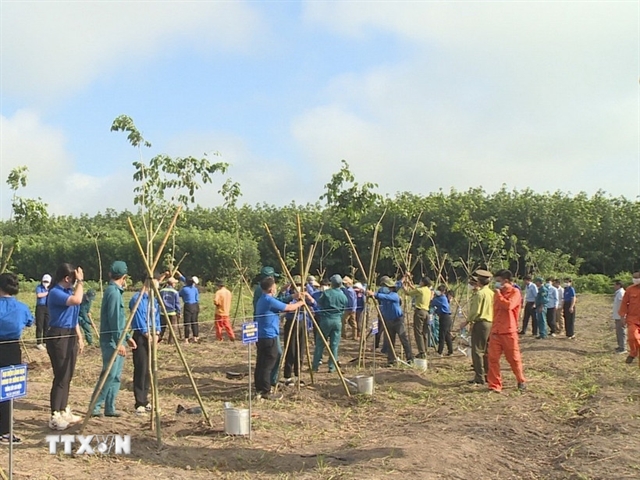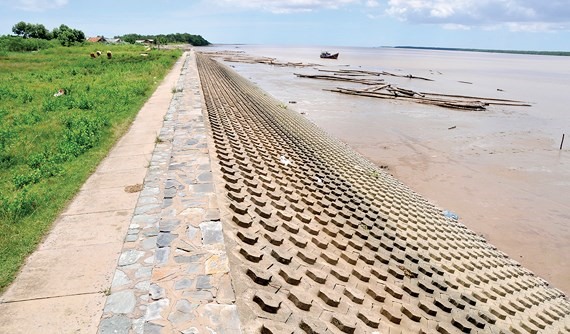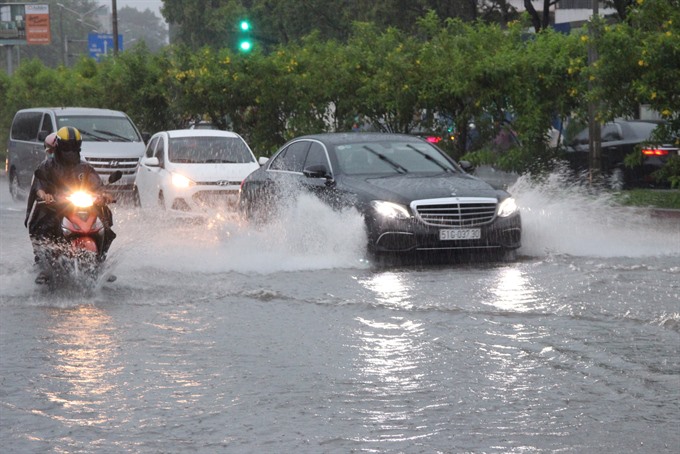 Environment
Environment

The Ministry of Agriculture and Rural Development is seeking approval from the Government to build a Vũng Tàu – Gò Công sea dyke in an effort to combat waterlogging in HCM City.
 |
| Construction of the Vũng Tàu – Gò Công sea dyke is expected to help HCM City cope with waterlogging, according to experts. Photo courtesy of sggp.org.vn |
HCM CITY – The Ministry of Agriculture and Rural Development is seeking approval from the Government to build a Vũng Tàu – Gò Công sea dyke in an effort to combat waterlogging in HCM City.
In recent years, the city has spent a great deal of money to prevent waterlogging, which occurs when the soil is saturated with water.
However, rapid urban development, together with poor management and inefficient urban planning, has reduced the city’s water storage space and limited water transport capacity of the city’s canal system.
The impact of climate change and rising sea levels have also increased flooding and salt intrusion in the Đồng Tháp Mười area and HCM City, according to experts.
Heavy rains along the Đồng Nai – Sài Gòn River, together with high tides, have placed pressure on the city’s drainage system, worsening waterlogging.
The city is a flood-prone spot as it is located downstream of the Đồng Nai River system, and has low-lying terrain, according to Dr Trần Bá Hoằng at the Southern Institute of Water Resources Research.
The proposed Vũng Tàu – Gò Công sea dyke would be extended from Tiền Giang Province’s Gò Công Commune to a point 5km from Bà Rịa - Vũng Tàu Province’s Vũng Tàu City, where it would connect with another dyke 13km long extending to Cần Giờ Biosphere Reserve in HCM City.
The main dyke would be 28km long and 25m wide, with an average water depth of 6.5m. The dyke scale would be 600m to 2000m wide.
In addition to the main dyke, the project includes construction of multiple drainage ditches, a Lòng Tàu sluice, and dams along Đồng Tranh and Soài Rạp rivers.
The project is based on a regional irrigation master plan, the technological capacity of Việt Nam, and similar project experiences from the Netherlands, South Korea and Japan.
Total investment of the Vũng Tàu – Gò Công sea dyke project would be about VNĐ74 trillion (US$3.6 billion).
To be implemented in three phases, it would also contribute to socio-economic development in the region, experts said.
 |
| HCM City’s Nguyễn Hữu Cảnh Street is usually flooded after rain. Rapid urban development, together with poor management and inefficient urban planning, has reduced the city’s water storage space and limited the water transport capacity of the city’s canal system. — VNA/VNS Photo Xuân Dự |
Multiple benefits
In addition to preventing floods and saline intrusion in HCM City, the project would bring other benefits.
Professor Nguyễn Quang Kim, president of Water Resources University, said that even if the sea level increases by 75cm by 2100, the Vũng Tàu – Gò Công sea dyke would still prevent floods across the downstream of the Đồng Nai –Sài Gòn River and canal system.
The project would help conserve the Cần Giờ mangrove forest ecosystem, since it would leave an open space at the Gành Rái Gulf, allowing a natural exchange of fresh and salt water in Cần Giờ.
Compared to other projects, this proposal would be less harmful to the environment.
Meanwhile, Dr Nguyễn Bá Ân from the Development Strategy Institute under the Ministry of Planning and Investment said HCM City and neighboring areas would see less damage if the sea dyke was completed.
As it does not require land clearance, the dyke is expected to be completed within two to three years and the ditches within three to four years.
In general, construction progress would not affect the Cần Giờ forest and traffic to Cái Mép – Thị Vải deep-water port, while in the next 70 years, it would not affect water traffic to HCM City.
For locals who now grow clams at the river gate and outside Cần Giờ forest, authorities will help them find jobs in travel or service industries.
The Vũng Tàu – Gò Công sea dyke project is also expected to lead to the formation of new urban areas along the river and sea coasts. – VNS